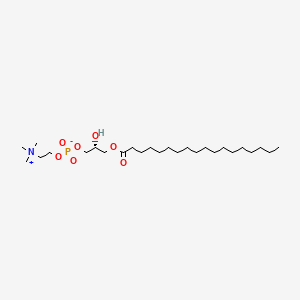
|
1-octadecanoyl-sn-glycero-3-phosphocholine |
1-octadecanoyl-sn-glycero-3-phosphocholine is a lipid of Glycerophospholipids (GP) class. 1-octadecanoyl-sn-glycero-3-phosphocholine is associated with abnormalities such as Septicemia. The involved functions are known as Phosphorylation, MAP kinase activity, Phagocytosis, protein serine/threonine kinase activity and Uptake. The associated genes with 1-octadecanoyl-sn-glycero-3-phosphocholine are FPR1 gene and OLR1 gene. The related lipids are Lysophosphatidylcholines. |
42 |
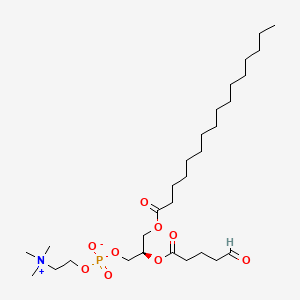
|
POV-PC |
POV-PC is a lipid of Glycerophospholipids (GP) class. Pov-pc is associated with abnormalities such as Atherosclerosis, Coronary Artery Disease, BOSLEY-SALIH-ALORAINY SYNDROME, Coronary Arteriosclerosis and Hypercholesterolemia. The involved functions are known as Metabolic Inhibition, Binding (Molecular Function), Tissue Adhesions, Oxidation and Cell Communication. Pov-pc often locates in Endothelium, Arterial system, Membrane, Cell surface and Plasma membrane. The associated genes with POV-PC are PCDH8 gene, CS1 peptide, MYOZ2 gene, SLC33A1 gene and Genes, Reporter. The related lipids are oxidized-L-alpha-1-palmitoyl-2-arachidonoyl-sn-glycero-3-phosphorylcholine, 1-palmitoyl-2-glutaroyl-sn-glycero-3-phosphorylcholine, oxidized lipid, LYSO-PC and Lipopolysaccharides. The related experimental models are Knock-out. |
135 |

|
tacrolimus |
Tacrolimus is a lipid of Polyketides (PK) class. Tacrolimus is associated with abnormalities such as Renal glomerular disease. The involved functions are known as inhibitors, Fungicidal activity, Metabolic Inhibition, Excretory function and Dephosphorylation. Tacrolimus often locates in Hepatic, Mitochondrial matrix and Inner mitochondrial membrane. The associated genes with Tacrolimus are RHOA gene and BGN gene. |
12730 |

|
Azithramycine |
Azithramycine is a lipid of Polyketides (PK) class. Azithramycine is associated with abnormalities such as Respiratory Tract Infections, Pneumonia, Lower respiratory tract infection, Infection and Nonspecific urethritis. The involved functions are known as Lysis, Selection, Genetic, Mutation, Relapse and Adaptation. Azithramycine often locates in Blood, Respiratory System, Genitourinary system, Back and Chest. The associated genes with Azithramycine are Genes, rRNA, Genome, RPL22 gene, OPRM1 gene and tryptic soy broth. The related lipids are Liposomes, Phosphatidylserines, Promega, Lipopolysaccharides and Steroids. The related experimental models are Mouse Model, Knock-out and Tissue Model. |
7835 |

|
clarithromycin |
clarithromycin is a lipid of Polyketides (PK) class. Clarithromycin is associated with abnormalities such as Helicobacter Pylori Infection, Infection, Coinfection, Gastritis and Peptic Ulcer. The involved functions are known as Point Mutation, Increased Sensitivy, Bacterial resistance, urease activity and Mutation. Clarithromycin often locates in Blood, Gastric mucosa, Biopsy sample, Respiratory System and Entire gastrointestinal tract. The associated genes with clarithromycin are Genes, rRNA, rRNA Operon, Genome, HM13 gene and GDF15 gene. The related lipids are 9,11-linoleic acid, Steroids, Lysophosphatidylcholines, Lipopolysaccharides and 4-hydroxycholesterol. The related experimental models are Mouse Model, Knock-out and Experimental Pneumococcal Meningitis. |
10449 |

|
minocycline |
minocycline is a lipid of Polyketides (PK) class. Minocycline is associated with abnormalities such as Infection, Soft Tissue Infections, Septicemia, Chronic hyponatremia and Lesion of brain. The involved functions are known as Pharmacodynamics, Gene Expression, Transcriptional Activation, Regulation and Process. Minocycline often locates in Ribosomes, 50S ribosomal subunit, Blood, Skin and Immune system. The associated genes with minocycline are THEMIS gene, KCNK2 gene, RBFOX3 gene, PIWIL2 gene and P4HTM gene. The related lipids are Lipopolysaccharides, Promega, Steroids, Liposomes and Octanols. The related experimental models are Mouse Model, Experimental Autoimmune Encephalomyelitis, Genetically Engineered Mouse, Disease model and spinal model. |
9780 |

|
CYTOCHALASIN B |
CYTOCHALASIN B is a lipid of Polyketides (PK) class. Cytochalasin b is associated with abnormalities such as Renal tubular disorder and Chagas Disease. The involved functions are known as Membrane Protein Traffic, inhibitors, Metabolic Inhibition, Biochemical Pathway and Increased Sensitivy. Cytochalasin b often locates in Cytoplasmic matrix, Plasma membrane, Microtubules, Extracellular and Protoplasm. The associated genes with CYTOCHALASIN B are SLC2A2 gene, PFDN5 gene, SLC2A1 gene, OMG gene and SPEN gene. The related lipids are Steroids, Lipopolysaccharides and Liposomes. The related experimental models are Xenograft Model. |
9648 |
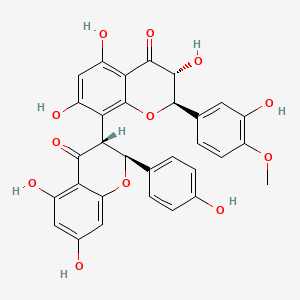
|
Kolaflavanone |
Kolaflavanone is a lipid of Polyketides (PK) class. Kolaflavanone is associated with abnormalities such as Diabetes, Hyperglycemia and Diabetic Nephropathy. The involved functions are known as Lipid Peroxidation, cholesterol biosynthetic process, Process, Excretory function and Apoptosis. Kolaflavanone often locates in Renal Tissue and Kidney - Cortex - Glomerulus (MMHCC). The associated genes with Kolaflavanone are Serum Albumin and TNF gene. The related lipids are Total cholesterol. |
125 |
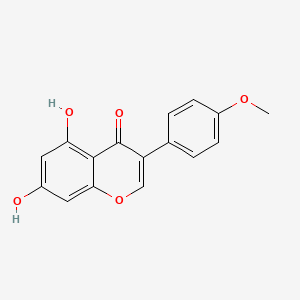
|
biochanin A |
Biochanin a is a lipid of Polyketides (PK) class. Biochanin a is associated with abnormalities such as Osteoporosis. The involved functions are known as Uptake, adenosinetriphosphatase activity, inhibitors, Drug Interactions and Metabolic Inhibition. Biochanin a often locates in Membrane, Tissue membrane, Microsomes, Microsomes, Liver and Entire oral cavity. The associated genes with Biochanin A are CD9 gene, SLCO1B1 gene, ABCG2 gene, EDNRB gene and SPAG8 gene. The related lipids are Steroids, Androstenols, Sphingolipids and 1,2-oleoylphosphatidylcholine. |
465 |

|
quercetin |
quercetin is a lipid of Polyketides (PK) class. Quercetin is associated with abnormalities such as Coronary heart disease, Myocardial Infarction, Cirrhosis, Coronary Arteriosclerosis and Vascular ring. The involved functions are known as Vasodilation, physiological aspects, Fermentation, Process and Ingredient. Quercetin often locates in Arterial system, Endothelium, Skin, Endothelium, Vascular and Tissue specimen. The associated genes with quercetin are P4HTM gene, SULT gene, UGT1A1 gene, ARHGAP26 gene and PLXNB1 gene. The related lipids are blood lipid, Promega, Steroids, Phosphatidylserines and Fatty Acids. The related experimental models are Knock-out, Mouse Model, Xenograft Model, Tissue Model and Cancer Model. |
5377 |

|
naringenin |
naringenin is a lipid of Polyketides (PK) class. Naringenin is associated with abnormalities such as Dehydration, Papillon-Lefevre Disease, BOSLEY-SALIH-ALORAINY SYNDROME, Cardiovascular Diseases and Atherosclerosis. The involved functions are known as Pigmentation, Biosynthetic Pathways, metaplastic cell transformation, 4-coumarate-CoA ligase activity and Pigment. Naringenin often locates in Body tissue, Cell Wall, Membrane, Cytoplasmic matrix and Tissue membrane. The associated genes with naringenin are Genome, Genes, Regulator, Alleles, Homologous Gene and SPEN gene. The related lipids are Fatty Acids, Total cholesterol, Lipopolysaccharides, Oleates and Cholesterol, Dietary. The related experimental models are Knock-out and Mouse Model. |
2420 |

|
doxorubicin |
Adriamycin is a lipid of Polyketides (PK) class. Adriamycin is associated with abnormalities such as Cardiomyopathies. The involved functions are known as Transcription, Genetic, Process, Drug effect disorder, Diastasis and Oxidation-Reduction. Adriamycin often locates in Muscle, Myocardium and Entire gastrointestinal tract. |
54913 |
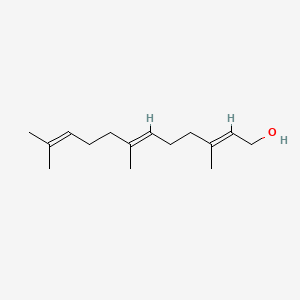
|
2E,6E-farnesol |
2e,6e-farnesol is a lipid of Prenol Lipids (PR) class. 2e,6e-farnesol is associated with abnormalities such as Granulomatous Disease, Chronic, pathologic fistula and Cavitation. The involved functions are known as Regulation, Metabolic Inhibition, cholesterol biosynthetic process, Process and Transcription, Genetic. 2e,6e-farnesol often locates in Plasma membrane, Cytoplasmic matrix, cornified envelope, Epidermis and peroxisome. The associated genes with 2E,6E-farnesol are RAB3A gene, FOSL1 gene, CASP8AP2 gene, RCC1 gene and GALE gene. The related lipids are Sterols, Membrane Lipids and Steroids. |
1905 |
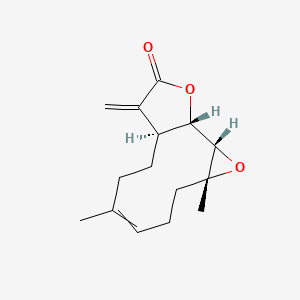
|
Parthenolide |
Parthenolide is a lipid of Prenol Lipids (PR) class. Parthenolide is associated with abnormalities such as Migraine Disorders, abnormal fragmented structure, Hyperostosis, Diffuse Idiopathic Skeletal, Consumption-archaic term for TB and Infection. The involved functions are known as Apoptosis, Cell Proliferation, Inflammation, pathologic cytolysis and Membrane Potentials. Parthenolide often locates in Mitochondria, Tissue membrane, Cytoplasmic matrix, Cytoplasm and Body tissue. The associated genes with Parthenolide are IGKJ1 gene, BCL2 gene, DDIT3 gene, Procaspase 7 and GAPDH gene. The related lipids are A(2)C. The related experimental models are Mouse Model, Xenograft Model, Breast Cancer Model and Cancer Model. |
925 |
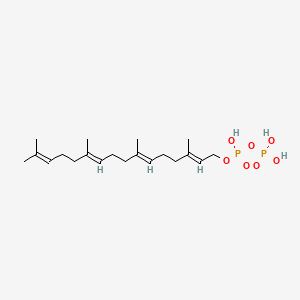
|
Geranylgeranyl diphosphate |
Geranylgeranyl diphosphate is a lipid of Prenol Lipids (PR) class. The involved functions are known as RNA Interference, Anabolism, Cytokinesis, Gene Expression and physiological aspects. Geranylgeranyl diphosphate often locates in soluble, Skeletal system, Cell-Free System, Plasma membrane and soluble fraction. The associated genes with Geranylgeranyl diphosphate are Genome, IMPACT gene, Open Reading Frames, Gene Clusters and Genes, Regulator. The related lipids are Fatty Acids, Sterols, terpentetriene and Membrane Lipids. |
885 |

|
forskolin |
Forskolin is a lipid of Prenol Lipids (PR) class. Forskolin is associated with abnormalities such as Cholestasis, Vocal cord dysfunction familial, Hypothyroidism, Renal tubular disorder and Disintegration (morphologic abnormality). The involved functions are known as Cell Proliferation, Anabolism, mRNA Expression, Agent and Signal. Forskolin often locates in Extracellular, Body tissue, Skin, Tissue membrane and Membrane. The associated genes with forskolin are P4HTM gene, SLC33A1 gene, NR1I2 gene, Genes, Reporter and CYP3A gene. The related lipids are Steroids, steroid sulfate, Fatty Acids, LYSO-PC and Lipopolysaccharides. |
24755 |
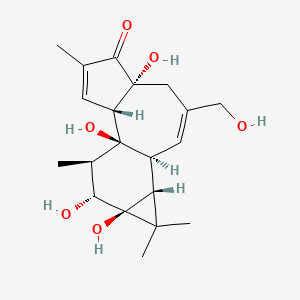
|
Phorbol |
Phorbol is a lipid of Prenol Lipids (PR) class. Phorbol is associated with abnormalities such as furuncle, Infection, endothelial dysfunction, Morphologically altered structure and Acute erythroleukemia. The involved functions are known as Tyrosine Phosphorylation, Metabolic Inhibition, Transcription, Genetic, Protein Biosynthesis and Signal. Phorbol often locates in Tissue membrane, Membrane, Cell surface, soluble and Cytoplasmic Domain. The associated genes with Phorbol are STAT3 gene, JAK2 gene, JUN gene, PROC gene and MAPK8 gene. The related lipids are Lipopolysaccharides, Phosphatidylserines, Liposomes, Fatty Acids and Octanols. |
2082 |

|
phorbol 13-acetate 12-myristate |
Phorbol 13-acetate 12-myristate is a lipid of Prenol Lipids (PR) class. The involved functions are known as DNA Fragmentation, Phosphorylation and Irritation. Phorbol 13-acetate 12-myristate often locates in low-density lipoprotein particle. The associated genes with phorbol 13-acetate 12-myristate are FPR1 gene and ABCB1 gene. |
40921 |

|
Sphingosine 1-phosphate |
Sphingosine 1-phosphate is a lipid of Sphingolipids (SP) class. Sphingosine 1-phosphate is associated with abnormalities such as Infection, Painful Bladder Syndrome, Atherosclerosis, Hyperglycemia and Rheumatoid Arthritis. The involved functions are known as Phosphorylation, Regulation, enzyme activity, Energy Absorption and Vascular Permeability. Sphingosine 1-phosphate often locates in Endothelium, Tissue membrane, Vascular System, Protoplasm and Microfilaments. The associated genes with Sphingosine 1-phosphate are MBTPS1 gene, FBXL15 gene, TEK gene, NTRK1 gene and Gene Family. The related lipids are Promega, Lipopolysaccharides, lysophosphatidic acid, Lysophosphatidylcholines and Lysophospholipids. The related experimental models are Knock-out, Mouse Model, Transgenic Model, Disease model and Experimental Autoimmune Encephalomyelitis. |
2005 |
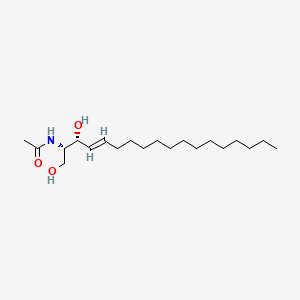
|
N-acetylsphingosine |
N-acetylsphingosine is a lipid of Sphingolipids (SP) class. N-acetylsphingosine is associated with abnormalities such as Morphologically altered structure, Atherosclerosis, Cardiovascular Diseases, Hyperinsulinism and Gigantism. The involved functions are known as inhibitors, anti-apoptosis, Apoptosis, Dephosphorylation and immunoreactivity. N-acetylsphingosine often locates in Plasma membrane, Mitochondria, Pore, Membrane and Cytoplasmic matrix. The associated genes with N-acetylsphingosine are EGR3 gene, CFB gene, FATE1 gene, P4HTM gene and PFDN4 gene. The related lipids are Sphingolipids, Cardiolipins, Glycerophospholipids, dihydroceramide and Phosphatidic Acid. |
633 |

|
cholesterol |
cholesterol is a lipid of Sterol Lipids (ST) class. Cholesterol is associated with abnormalities such as Trypanosomiasis, Chagas Disease, Cleft Palate, Chondrodysplasia punctata 2, X-linked dominant and Child syndrome. The involved functions are known as Blood Circulation, Sterol Biosynthesis Pathway, Receptor Mediated Endocytosis, Methylation and Signal. Cholesterol often locates in Animal tissue, Blood, Membrane, Plasma membrane and peroxisome. The associated genes with cholesterol are MBD2 gene, SIM, SLC33A1 gene, Genome and NSDHL gene. The related lipids are Sterols, zymosterol, fecosterol, Total cholesterol and 7-dehydrocholesterol. The related experimental models are Mouse Model, Knock-out, Genetically Engineered Mouse and Disease model. |
98461 |
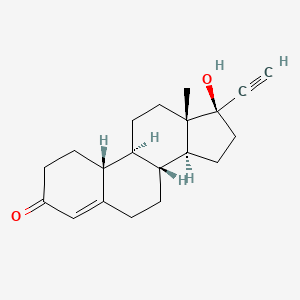
|
Norethindrone |
Norethindrone is a lipid of Sterol Lipids (ST) class. Norethindrone is associated with abnormalities such as Endometriosis, site unspecified, Wiskott-Aldrich Syndrome and Estrogenic effect. The involved functions are known as Hemorrhage, Phosphorylation, Apoptosis, DNA Repair and Cell Cycle. Norethindrone often locates in Blood, Back, Body tissue, Nucleolar and Human tissue. The associated genes with Norethindrone are MMP gene, NR3C1 gene and Genes, Reporter. The related lipids are Steroids, 4,17 beta-dihydroxy-4-androstene-3-one, 4-estren-3,17-diol and Estranes. |
2411 |

|
Norgestrel |
Norgestrel is a lipid of Sterol Lipids (ST) class. Norgestrel is associated with abnormalities such as Acne, Deep Vein Thrombosis, Thromboembolism, Activated Protein C Resistance and Hydrometra. The involved functions are known as Thrombosis, Aquatic environment, Venous Thrombosis, Thrombus and Inspiration function. Norgestrel often locates in Glial. The associated genes with Norgestrel are Genes, Reporter. The related lipids are Estranes. |
3031 |
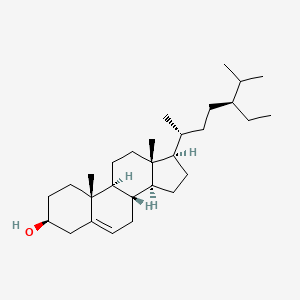
|
Clionasterol |
Clionasterol is a lipid of Sterol Lipids (ST) class. The involved functions are known as Intestinal Absorption. The related lipids are 22-hydroxycholesterol. |
711 |
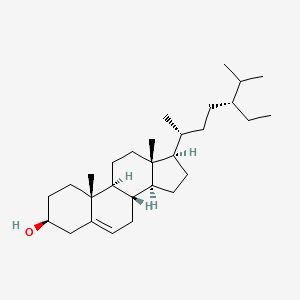
|
Beta-sitosterol |
Beta-sitosterol is a lipid of Sterol Lipids (ST) class. Beta-sitosterol is associated with abnormalities such as Obesity, Diabetes, Cholestasis, Systemic disease and Diabetes Mellitus. The involved functions are known as Increased Cholesterol Synthesis, Synthesis, cholesterol metabolism, GLUCOSE TOLERANCE and cholesterol absorption. Beta-sitosterol often locates in Blood, Back, Cell membrane, soluble fraction and Body tissue. The related lipids are Sterols, lathosterol, Total cholesterol, campesterol and Cholestanes. |
380 |
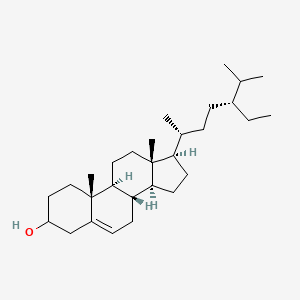
|
3beta-sitosterol |
|
234 |
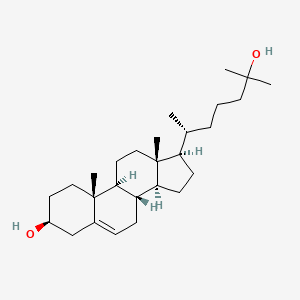
|
25-Hydroxycholesterol |
25-Hydroxycholesterol is a lipid of Sterol Lipids (ST) class. 25-hydroxycholesterol is associated with abnormalities such as Hereditary Diseases, Atherosclerosis, Fatty Liver, Infection and Exanthema. The involved functions are known as Binding (Molecular Function), cholesterol binding, sterol binding, oxysterol binding and Regulation. 25-hydroxycholesterol often locates in Membrane, Golgi membrane, Cellular Membrane, Cytoplasmic matrix and Golgi Apparatus. The associated genes with 25-Hydroxycholesterol are PTPN7 gene, OSBP gene, N-glycylalanine, SCAP gene and TSPO gene. The related lipids are 25-hydroxycholesterol, Sterols, Hydroxycholesterols, 27-hydroxycholesterol and Steroids. The related experimental models are Knock-out. |
757 |

|
Equilin |
Equilin is a lipid of Sterol Lipids (ST) class. |
61 |
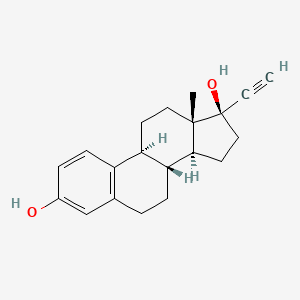
|
17alpha-Ethinyl estradiol |
17alpha-ethinyl estradiol is a lipid of Sterol Lipids (ST) class. 17alpha-ethinyl estradiol often locates in Microsomes. The related lipids are 7-dehydrocholesterol. |
7716 |

|
22-Hydroxycholesterol |
22-Hydroxycholesterol is a lipid of Sterol Lipids (ST) class. 22-hydroxycholesterol is associated with abnormalities such as Hypertensive disease, Cardiovascular Diseases, Congestive heart failure, Atherosclerosis and Hypercholesterolemia. The involved functions are known as physiological aspects, Regulation, Anabolism, Metabolic Inhibition and Adjudication. 22-hydroxycholesterol often locates in Body tissue, Blood, Mitochondria, Membrane and Tissue membrane. The associated genes with 22-Hydroxycholesterol are Candidate Disease Gene, ABCA1 gene, CLTC gene, SLC22A1 gene and SLC10A1 gene. The related lipids are Hydroxycholesterols, Lipopolysaccharides, 22-hydroxycholesterol, Fatty Acids and (22R)-22-hydroxycholesterol. |
210 |

|
22(r)-hydroxycholesterol |
22(r)-hydroxycholesterol is a lipid of Sterol Lipids (ST) class. 22(r)-hydroxycholesterol is associated with abnormalities such as Transient Ischemic Attack, Still, Neurodegenerative Disorders and Senile Plaques. The involved functions are known as Binding (Molecular Function), inhibitors, mRNA Expression, Gene Expression and Transcription, Genetic. 22(r)-hydroxycholesterol often locates in Blood, Protoplasm, Extracellular, Cytosol and Cytoplasm. The associated genes with 22(r)-hydroxycholesterol are CCL2 gene, IL8RB gene, CALCA gene and GRM5 gene. The related lipids are 22-hydroxycholesterol, Lipopolysaccharides, 15-deoxyprostaglandin J2 and 7-ketocholesterol. |
70 |

|
22(s)-hydroxycholesterol |
22(s)-hydroxycholesterol is a lipid of Sterol Lipids (ST) class. 22(s)-hydroxycholesterol is associated with abnormalities such as Transient Ischemic Attack, Still, Neurodegenerative Disorders and Senile Plaques. The involved functions are known as Binding (Molecular Function), inhibitors, mRNA Expression, Gene Expression and Transcription, Genetic. 22(s)-hydroxycholesterol often locates in Blood, Protoplasm, Extracellular, Cytosol and Cytoplasm. The associated genes with 22(s)-hydroxycholesterol are CCL2 gene, IL8RB gene, CALCA gene and GRM5 gene. The related lipids are 22-hydroxycholesterol, Lipopolysaccharides, 15-deoxyprostaglandin J2 and 7-ketocholesterol. |
70 |

|
Cholest-5-ene |
Cholest-5-ene is a lipid of Sterol Lipids (ST) class. |
219 |
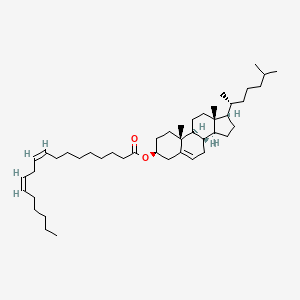
|
18:2 Cholesteryl ester |
18:2 cholesteryl ester is a lipid of Sterol Lipids (ST) class. |
70 |
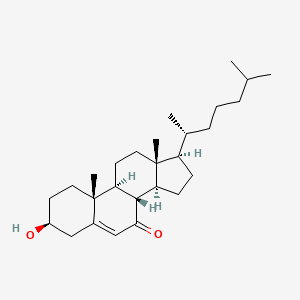
|
7-Ketocholesterol |
7-Ketocholesterol is a lipid of Sterol Lipids (ST) class. 7-ketocholesterol is associated with abnormalities such as Atherosclerosis, Age related macular degeneration, Drusen, Cardiovascular Diseases and Hypercholesterolemia. The involved functions are known as mRNA Expression, Choroidal Neovascularization, Biochemical Pathway, Inflammation and Regulation. 7-ketocholesterol often locates in Basal lamina of choroid, Mitochondria, Epithelium, Frozen Sections and Membrane. The associated genes with 7-Ketocholesterol are ABCA1 gene, SLC33A1 gene, GAPDH gene, P4HTM gene and TSPO gene. The related lipids are Ketocholesterols, cholesterol oxide, Sterols, oxidized lipid and 7-ketocholesterol. The related experimental models are Knock-out and Mouse Model. |
397 |

|
Taurocholic acid |
Taurocholic acid is a lipid of Sterol Lipids (ST) class. Taurocholic acid is associated with abnormalities such as Cholestasis, Cholestatic liver disease, Exanthema, Hepatitis and Fibrosis, Liver. The involved functions are known as Uptake, Metabolic Inhibition, Drug Interactions, inhibitors and Excretory function. Taurocholic acid often locates in Hepatic, Plasma membrane, Blood, Membrane and Endothelium. The associated genes with Taurocholic acid are SLC10A1 gene, SLCO1B1 gene, SLC10A2 gene, P4HTM gene and Polypeptides. The related lipids are Steroids, Sterols, Lipopolysaccharides, 7-dehydrocholesterol and cholanic acid. |
3446 |



































